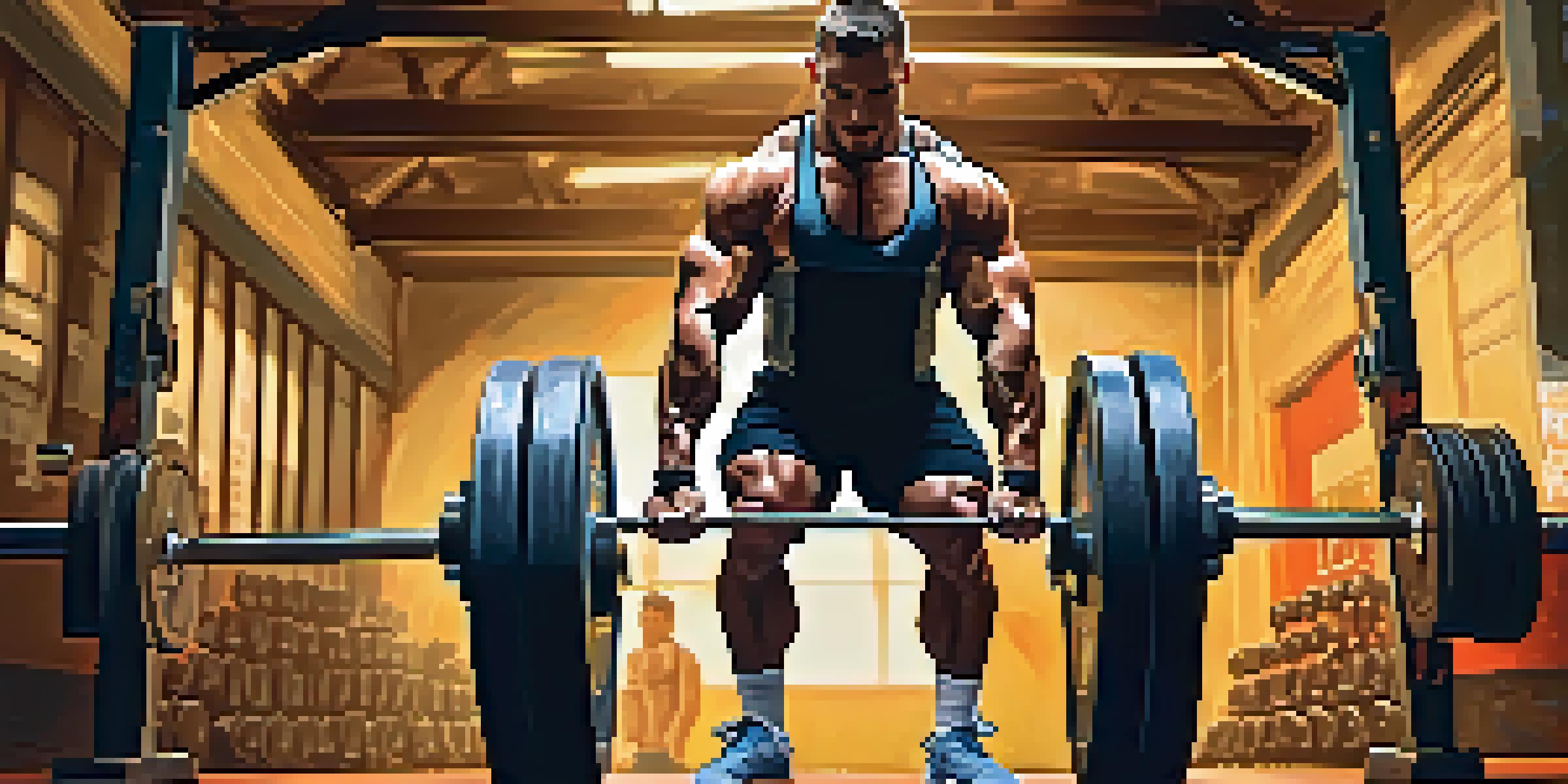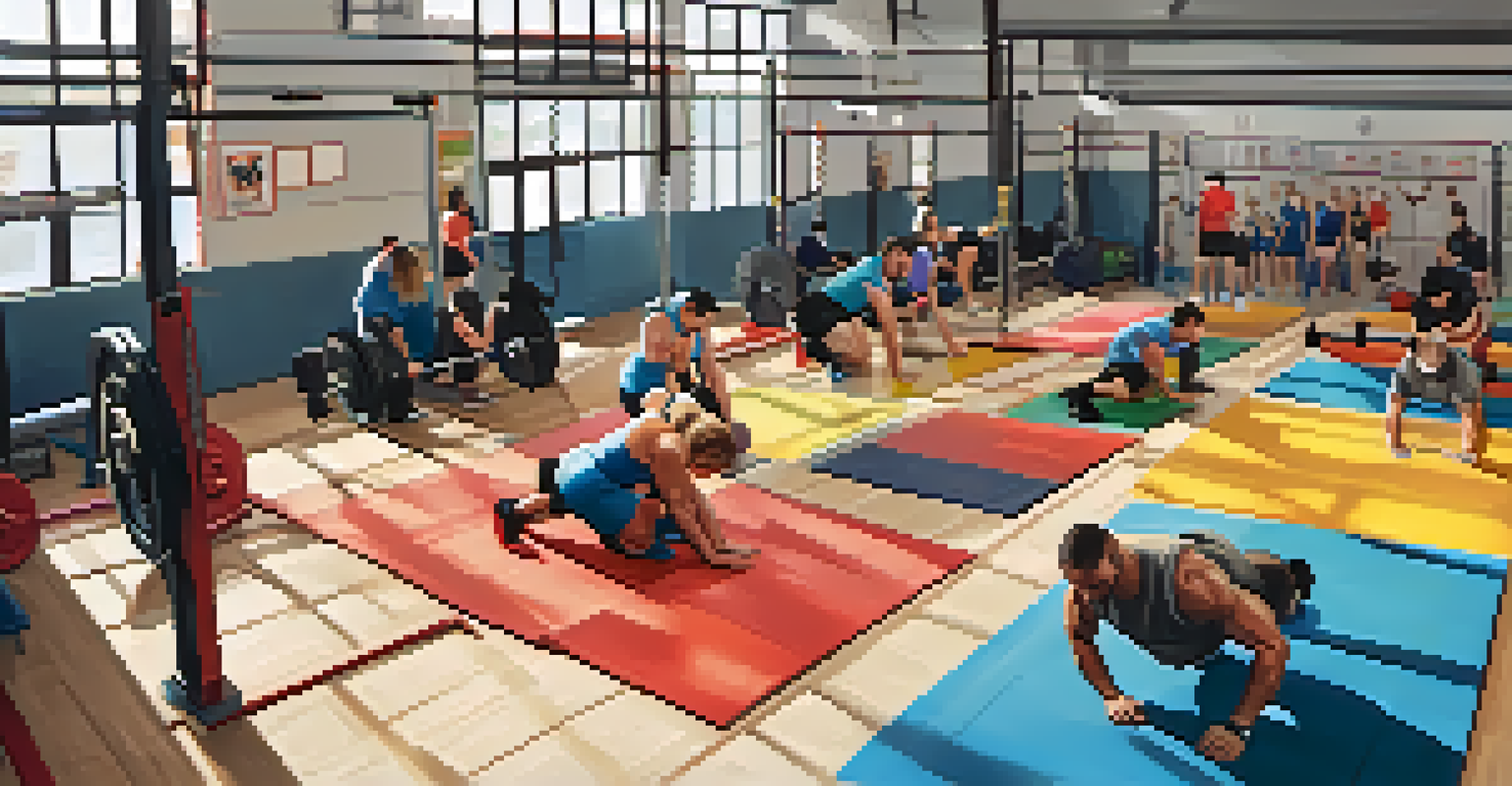The Role of Core Strength in Preventing Powerlifting Injuries

Understanding Core Strength and Its Importance
Core strength refers to the stability and strength of the muscles in your abdomen, lower back, and pelvis. These muscles play a crucial role in maintaining proper posture and balance, especially during heavy lifts. A strong core acts as a foundation that supports your body during intense physical activities like powerlifting.
The core is the foundation of all movement. If your core is weak, your whole body is weak.
When lifting heavy weights, the core helps transfer power effectively from your lower body to your upper body. This not only enhances performance but also reduces the risk of injuries that can occur from improper lifting techniques. Without a strong core, lifters may struggle to maintain proper form, leading to imbalances and potential injuries.
In essence, developing core strength is essential not just for powerlifters but for anyone engaging in physical activity. By building a solid core, you ensure that your body can handle the demands of lifting while protecting your spine and joints from undue stress.
Common Injuries in Powerlifting and Their Causes
Powerlifting, while rewarding, comes with its fair share of injury risks. Common injuries include strains in the lower back, shoulders, and knees, often resulting from improper technique or lack of muscle support. These injuries can sideline athletes for weeks or even months, affecting both their training and competition schedules.

Many times, these injuries stem from weak core muscles, which fail to stabilize the spine during heavy lifts. When the core is not engaged, the surrounding muscles have to compensate, leading to overuse and, ultimately, injury. This highlights the need for a well-rounded strength training program that prioritizes core development.
Core Strength Is Essential for Lifters
A strong core is vital for maintaining proper lifting technique, preventing injuries, and enhancing overall performance in powerlifting.
Moreover, understanding the mechanics of your body during lifts can help pinpoint potential issues before they escalate into injuries. By being aware of the signs and symptoms of common powerlifting injuries, athletes can take proactive steps to address them, like focusing on core strength.
How Core Strength Affects Lifting Technique
Proper lifting technique is paramount in powerlifting, and core strength significantly influences this aspect. A strong core helps maintain an upright torso during lifts, which is critical for performing exercises like squats and deadlifts safely. When the core is weak, lifters may lean forward or compromise their form, increasing the likelihood of injury.
Strength does not come from physical capacity. It comes from an indomitable will.
Engaging the core throughout the lifting process stabilizes the spine and allows for better control of the weight being lifted. This stability not only enhances performance but also fosters a sense of confidence, allowing lifters to push their limits without fear of injury. Think of the core as the anchor of a ship; without it, the ship may sway and capsize.
By practicing proper technique and engaging the core effectively, lifters can maximize their strength and minimize injury risks. This means incorporating core exercises into training routines, ensuring that lifters are well-prepared for both the physical and technical demands of powerlifting.
Core Exercises for Powerlifters: What to Include
To build a strong core, powerlifters should incorporate specific exercises into their training regimen. Planks, dead bugs, and Russian twists are excellent options that target various core muscle groups. These exercises not only build strength but also enhance stability and endurance, crucial for heavy lifting.
Additionally, compound movements like squats and deadlifts can also serve as core exercises when performed correctly. Engaging the core during these lifts helps reinforce proper mechanics while simultaneously building strength. This dual benefit makes these lifts essential components of any powerlifting program.
Injuries Often Stem from Weak Core
Many common powerlifting injuries arise from weak core muscles that fail to stabilize the spine during heavy lifts.
It's important to remember that core training should be progressive and varied. Lifters can challenge their core with stability balls, resistance bands, or even kettlebells, ensuring that they develop a well-rounded core capable of supporting them during intense lifts.
The Role of Mobility in Core Strength and Injury Prevention
While core strength is vital, mobility also plays a crucial role in preventing injuries in powerlifting. A strong, mobile core allows for better range of motion during lifts, which can enhance performance and reduce injury risk. Flexibility in the hips, spine, and shoulders contributes to overall lifting mechanics.
Incorporating mobility exercises such as dynamic stretches and foam rolling can help maintain the flexibility necessary for effective lifting. These practices keep the muscles supple and prevent tightness, which can lead to compensations and injuries. Think of mobility work as oiling the gears in a machine; it keeps everything running smoothly.
By prioritizing both core strength and mobility, powerlifters can create a balanced approach to training. This not only improves performance but also fosters a safer lifting environment, allowing athletes to focus on their goals without the looming threat of injury.
The Mind-Body Connection: Focus and Core Engagement
The mind-body connection plays a significant role in lifting successfully and safely. Being mentally aware of core engagement during lifts is crucial for maintaining proper form and preventing injuries. This focus allows lifters to harness their inner strength, encouraging them to engage their core effectively throughout the lifting process.
Visualization techniques can be beneficial in reinforcing this connection. Athletes may mentally picture their core muscles stabilizing their spine as they lift, enhancing their ability to execute lifts with precision. This mental rehearsal not only boosts confidence but also serves as a reminder to maintain that core engagement.
Mobility Complements Core Strength
Improving mobility alongside core strength enhances lifting performance and reduces the risk of injury by promoting better range of motion.
Ultimately, fostering a strong mind-body connection can transform a lifter's performance. By being intentional about core engagement, lifters can enhance their technique, boost their strength, and significantly reduce the risk of injury.
Conclusion: Prioritizing Core Strength for Lifters
In conclusion, core strength is a fundamental aspect of powerlifting that cannot be overlooked. It plays a crucial role in maintaining proper technique, preventing injuries, and enhancing overall performance. By prioritizing core development in training, lifters can create a solid foundation for their athletic pursuits.
Incorporating a variety of core exercises, mobility work, and mental focus techniques will lead to a well-rounded approach to training. This not only promotes strength gains but also fosters a safer lifting environment, allowing athletes to push their limits without the fear of injury.

As you embark on your powerlifting journey, remember that a strong core is your best ally. By investing time and effort into core strength, you’re not just lifting weights; you’re building a resilient body capable of achieving your goals.